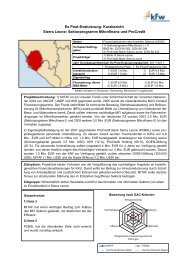Making partnerships work for health, focusing on low-income countries
Making partnerships work for health, focusing on low-income countries
Making partnerships work for health, focusing on low-income countries
You also want an ePaper? Increase the reach of your titles
YUMPU automatically turns print PDFs into web optimized ePapers that Google loves.
Andrew Harmer Panel 2: Role of the internati<strong>on</strong>al d<strong>on</strong>or community<br />
Panel 2:<br />
Role of the internati<strong>on</strong>al<br />
d<strong>on</strong>or community<br />
Global Health Public-<br />
Private Partnerships: What<br />
they are, what we know,<br />
and why they matter.<br />
Andrew Harmer<br />
Research Assistant, Health Policy Unit<br />
L<strong>on</strong>d<strong>on</strong> School of Hygiene and<br />
Tropical Medicine, UK<br />
Do <str<strong>on</strong>g>partnerships</str<strong>on</strong>g> impact positively or<br />
negatively <strong>on</strong> <strong>countries</strong>’ <str<strong>on</strong>g>health</str<strong>on</strong>g> systems,<br />
and if they do how do we know?<br />
What is the role of the private sector in<br />
strengthening <str<strong>on</strong>g>health</str<strong>on</strong>g> systems in <strong>low</strong>-<strong>income</strong><br />
<strong>countries</strong>? Indeed, what c<strong>on</strong>stitutes<br />
the ‘private’ sector in this c<strong>on</strong>text?<br />
What are we to make of private partners<br />
in public-private <str<strong>on</strong>g>partnerships</str<strong>on</strong>g>: what are<br />
their roles and resp<strong>on</strong>sibilities, and how<br />
might they c<strong>on</strong>tribute to making <str<strong>on</strong>g>partnerships</str<strong>on</strong>g><br />
<str<strong>on</strong>g>work</str<strong>on</strong>g> better? These are difficult<br />
questi<strong>on</strong>s, and there are no easy<br />
answers.<br />
Fortunately, where <strong>on</strong>ce there was an<br />
intractable ideological divide between<br />
prop<strong>on</strong>ents of ‘the public’ and prop<strong>on</strong>ents<br />
of ‘the private’ – making debate<br />
and dialogue between the two camps all<br />
but impossible – now there is open space<br />
and open minds <str<strong>on</strong>g>for</str<strong>on</strong>g> c<strong>on</strong>structive rather<br />
than adversarial discourse. This c<strong>on</strong>ference<br />
is <strong>on</strong>e example of this open space<br />
and, hopefully, open minds.<br />
The emergence of global <str<strong>on</strong>g>health</str<strong>on</strong>g> public-private<br />
<str<strong>on</strong>g>partnerships</str<strong>on</strong>g> is <strong>on</strong>e radical<br />
output from this shift in understanding;<br />
something tangible occupying the<br />
grey area between public and private<br />
spheres where magic happens. What do<br />
we know about these <str<strong>on</strong>g>partnerships</str<strong>on</strong>g>?<br />
To begin with, they are few in number;<br />
certainly not the 100+ so often cited<br />
in the literature. In fact, if by global<br />
<str<strong>on</strong>g>health</str<strong>on</strong>g> public-private <str<strong>on</strong>g>partnerships</str<strong>on</strong>g> we<br />
mean <str<strong>on</strong>g>partnerships</str<strong>on</strong>g> where both public<br />
and private sector representatives have<br />
a meaningful voice <strong>on</strong> their Board of<br />
Directors (i.e. where the real decisi<strong>on</strong>making<br />
takes place) then we barely get<br />
into double figures. That means that<br />
they are rare: rare, but special.<br />
GHPs are special <str<strong>on</strong>g>for</str<strong>on</strong>g> three fundamental<br />
reas<strong>on</strong>s. First they are a <str<strong>on</strong>g>for</str<strong>on</strong>g>um <str<strong>on</strong>g>for</str<strong>on</strong>g> the<br />
exchange of ideas and values – a place<br />
where the World Bank and the World<br />
Health Organizati<strong>on</strong> (WHO); where<br />
McKinsey and Bill and Mellinda Gates<br />
Foundati<strong>on</strong>; where NGOs such as Medecins<br />
sans Fr<strong>on</strong>tieres and Rockefeller<br />
can get together regularly and talk to<br />
<strong>on</strong>e another. This <str<strong>on</strong>g>for</str<strong>on</strong>g>um simply didn’t<br />
exist ten or twenty years ago.<br />
Sec<strong>on</strong>d, they re-define public and private<br />
sector actors as partners with clearly<br />
defined roles, resp<strong>on</strong>sibilities, and<br />
expectati<strong>on</strong>s about appropriate behavior.<br />
Transgressors lose credibility as bad<br />
partners; good partners earn respect and<br />
praise. Crucially, partners learn from<br />
<strong>on</strong>e another, and by increments their<br />
identities are re-shaped: from public or<br />
private to public-private partners.<br />
Third, they functi<strong>on</strong> as an accountability<br />
mechanism. Being a partner matters<br />
because commitments made are<br />
made transparently, documented, uploaded<br />
to the partnership’s website and<br />
thus available <str<strong>on</strong>g>for</str<strong>on</strong>g> scrutiny by the global<br />
<str<strong>on</strong>g>health</str<strong>on</strong>g> community. The Global Fund<br />
to Fight Aids, Tuberculosis and Malaria<br />
and GAVI have champi<strong>on</strong>ed this global<br />
98 99


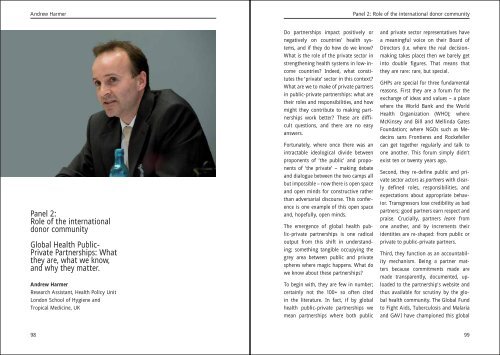
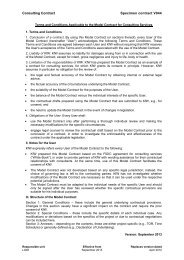

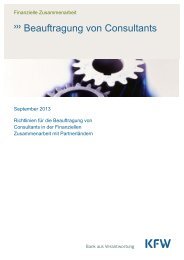


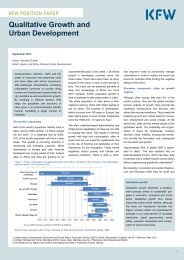
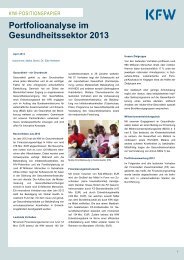

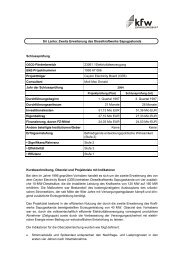
![Wasserversorgung Luang-Prabang I+II [2004] (PDF, 97 KB) - KfW ...](https://img.yumpu.com/21663442/1/184x260/wasserversorgung-luang-prabang-i-ii-2004-pdf-97-kb-kfw-.jpg?quality=85)
![Entwicklungsbank NDB I+II [2002] (PDF, 88 KB) - KfW ...](https://img.yumpu.com/21363284/1/184x260/entwicklungsbank-ndb-i-ii-2002-pdf-88-kb-kfw-.jpg?quality=85)
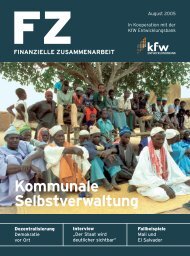

![Instandsetzung Baharia-Eisenbahnlinie I und II [2004] (PDF, 123 KB)](https://img.yumpu.com/21289660/1/184x260/instandsetzung-baharia-eisenbahnlinie-i-und-ii-2004-pdf-123-kb.jpg?quality=85)
